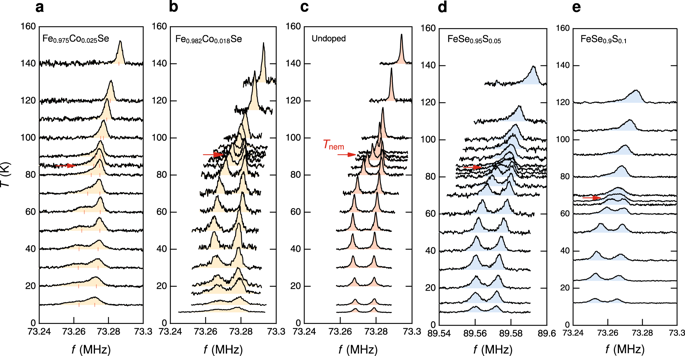npj Quantum Materials ( IF 5.4 ) Pub Date : 2020-01-30 , DOI: 10.1038/s41535-020-0211-y Seung-Ho Baek , Jong Mok Ok , Jun Sung Kim , Saicharan Aswartham , Igor Morozov , Dmitriy Chareev , Takahiro Urata , Katsumi Tanigaki , Yoichi Tanabe , Bernd Büchner , Dmitri V. Efremov

|
The interplay of orbital and spin degrees of freedom is the fundamental characteristic in numerous condensed matter phenomena, including high-temperature superconductivity, quantum spin liquids, and topological semimetals. In iron-based superconductors (FeSCs), this causes superconductivity to emerge in the vicinity of two other instabilities: nematic and magnetic. Unveiling the mutual relationship among nematic order, spin fluctuations, and superconductivity has been a major challenge for research in FeSCs, but it is still controversial. Here, by carrying out 77Se nuclear magnetic resonance (NMR) measurements on FeSe single crystals, doped by cobalt and sulfur that serve as control parameters, we demonstrate that the superconducting transition temperature Tc increases in proportion to the strength of spin fluctuations, while it is independent of the nematic transition temperature Tnem. Our observation therefore directly implies that superconductivity in FeSe is essentially driven by spin fluctuations in the intermediate coupling regime, while nematic fluctuations have a marginal impact on Tc.
中文翻译:

分别调节向列性和自旋涨落以阐明FeSe中超导的起源
轨道和自旋自由度的相互作用是许多凝聚态现象的基本特征,其中包括高温超导,量子自旋液体和拓扑半金属。在铁基超导体(FeSC)中,这会导致超导电性出现在另外两个不稳定性附近:向列和磁性。揭示向列序,自旋涨落和超导性之间的相互关系一直是FeSCs研究的主要挑战,但仍存在争议。在此,通过对掺有钴和硫作为控制参数的FeSe单晶进行77 Se核磁共振(NMR)测量,我们证明了超导转变温度T c与自旋涨落强度成比例地增加,而与向列转变温度T nem无关。因此,我们的观察结果直接表明,FeSe的超导性基本上是由中间耦合机制中的自旋波动驱动的,而向列波动对T c的影响很小。











































 京公网安备 11010802027423号
京公网安备 11010802027423号